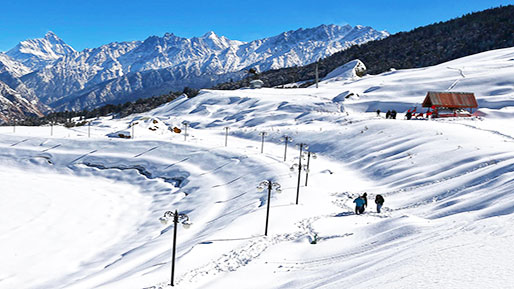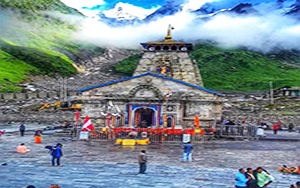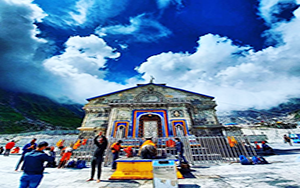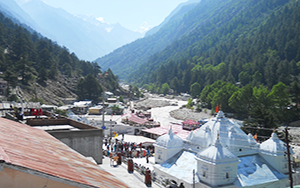Chardham yatra With Auli Tour From Delhi
The chardham yatra with Auli from Delhi is among the most revered pilgrimage destinations on earth. Four temples: Yamunotri, Gangotri, Kedarnath, and Badrinath, make up this pilgrimage. Another name for it is the Bharat Char Dham Yatra. Adi Shankaracharya established a second Dham Dham in contrast to these. They comprise four sacred pilgrimage sites, Badrinath, Dwarka Puri in Orissa, and Rameswaram in Tamil Tamilnadu, spread over four different geographic areas of the country.
The Kedarnath Dham, one of the Twelve Jyotirlingas, is dedicated to Lord Shiva. Lord Badri, also referred to as Vishnu, is revered in Badrinath Yatra. Both Gangotri and Yamunotri are dedicated to Mata Yamuna. If you wish to visit a char dham yatra and visit Auli as well, then here are some considerations that you must know.
Important Char Dham Yatra Advice
- These holy places are situated in Uttarakhand's Garhwal Himalayas. The voyage is often made from east to west. This signifies that it begins in Yamunotri and concludes at Gangotri, Kedarnath, and Badrinath. The following important details can aid you in your travel planning:
- Depending on your preference, the journey might begin in Delhi, Haridwar, Rishikesh, or Dehradun.
- Bring important papers with you on the trip, such as your passport, driver's licence, voter Identity card, PAN card, and Aadhar card.
- The Swiss Cottages have excellent camping options besides the shrine that are properly furnished with the necessities. Both luxurious and inexpensive lodging options are available.
- For the pilgrims, there is also a Chardham Yatra by helicopters
- Don't forget to pack a raincoat, winter jacket, gloves, sweater, and wool socks for the journey.
- While travelling, put on a pair of cosy, grippy shoes.
Which items should I bring on my trip?
Always keep a kit of necessary cold, cough, and fever medications. To prevent sunburn, wear sunscreen. When going in the sun, don a hat and sunglasses.
You must ensure that you have woollen clothes, like body heaters, sweaters, coats, caps, stockings, and gloves. You must also carry an umbrella, raincoat, and windbreaker for weather protection. Bring a waterproof bag and water-resistant shoes also. To explore more such exciting plans, you can take a look at our Chardham Plan.
Itinerary
-
Day 1: Delhi - Haridwar
Arrive at Delhi Airport/Railway Station and drive to Haridwar. Check into the hotel reach in Haridwar. Evening Ganga aarti at Har Ki Pauri, Mansa Devi Temple. Stay overnight at Haridwar.
-
Day 2: Haridwar - Mussoorie
The morning after breakfast check out and Drive to Mussoorie Visit local sightseeing.
1. Fort St. George, Zonal Museum, Robber's Cave, Forest Research Institute, Indian Military Academy, Tapkeshwar Mahadev Temple, Malsi Deer Park Overnight stay at Mussoorie Hotel. -
Day 3: Mussoorie - Barkot
Today morning after breakfast visit to local sightseeing (Gun Hill, Tibetan Temple, Company Garden & Lal tibia) and The Kempty Falls are situated on the hilly tracks, later drive to Barkot, Later breakfast checkout from the hotel, and drive to Barkot, drive straight to Barkot. Check into the hotel arrival in Barkot. Stay overnight at the Barkot.
-
Day 4: Barkot - Yamunotri - Barkot
Early morning after breakfast (packed breakfast), move to Jankichatti / Phoolchatti & star trek from here to Yamunotri (6kms) (Either by walk or by horse or by Doli at own cost). After taking a bath in Jamunabai Kund's warm water and having “Darshan” of “Yamunaji” back to Jankichatti by trek. Later moving towards Barkot, Stay overnight at Barkot.
Yamunotri Temple: Maharani Gularia of Jaipur constructed the temple in the 19th Century. It was destroyed twice in the present century and rebuilt again. At Yamunotri, One can cook rice by packing it in a cloth and dipping it in the hot water of the Tapt Kund. Pilgrims take this cooked rice home as “Prasad”. Here near the temple “Pooja” can be offered to Divya Shila.
Surya Kund: There are a Number of thermal springs near the temple, which flow into numerous pools. The most significant of these is Surya Kund.
Yamunotri Weather - In summer the maximum temp is 18 degrees and the minimum is 10 degrees Celsius. The days are pleasantly cool but the nights are cold. -
Day 5: Barkot - Uttarkashi
The morning after breakfast, move to Uttarkashi. Check into the hotel reached in Uttarkashi. Visit Kashi Vishwanath Temple in Uttarkashi. Stay overnight at the Uttarkashi. Uttarkashi is home to a number of ashrams, and temples. The name of the town reflects its similarity to and location (as north of) the city of Kashi (Varanasi). Similar to Varanasi, the town of Uttarkashi is also situated on the banks of River Ganga.
Vishwanath temple - Vishwanath temple is one of the oldest Shiva temples in Northern India. Rebuilt in 1857 by Maharani Khaneti Devi of Tehri State in the ancient architectural style. It is situated at the heart of the town. A heavy iron trident, symbolic of divine mothers, is erected and worshiped from time immemorial at the temple complex. Ganeshji, Sakshi Gopal, and Markandeya Rishi's small shrines are also part of the temple complex. Akhand Jyoti as well as Akhand Abhishek, special aarti in the morning and evening are offered. As per Skanda Puran, Uttarkashi is known as 'Saumya Varanasi', the abode of Lord Shiva in Kaliyug, and is counted as one of the twelve Jyotirlingas.
Shakti temple - Right in front of the Vishwanath temple is Shakti temple. It has a big 'Trishul (Trident)' of about 6 meters in height and a circumference of 90 cms. at bottom. Though there are different views about the making of this, the upper part of it seems to be made up of iron and the lower one is of copper. As per the epics, this Shakti was thrown on the devils by the Goddess Durga (Shakti), hence it gets its name. Since then this Shakti is erected over here.
Uttarkashi Weather - Generally hot in summer, the temperature ranges from 30-35 degrees Celsius but nights are pleasant, cold in winters. -
Day 6: Uttarkashi - Gangotri - Uttarkashi
Early morning (packed breakfast) move to Gangotri, on the way at Gangotri take a sacred dip in Garam Kund, and further drive to Gangotri via beautiful Harsil Valley. Harsil is famous for its natural beauty and for the majestic views of the Deodar trees and mountains. On arrival at Shree Gangotri, take a holy dip in the sacred river Ganges which is also called Bhagirathi at its origin. Perform Pooja and Darshan, after that rest for some time in the lovely surroundings. Later I got back to Uttarkashi. Stay overnight at Uttarkashi.
Gangotri Temple: The temple was built by the Gorkha General Amar Singh Thapa in the 18th Century, and is situated on the right bank of Bhagirathi.
Gangotri Weather : The maximum temperature during summer can go up to 20° Celsius. Summer nights can get cooler with a minimum temperature of 10° Celsius. Light woolen clothes are required while visiting Gangotri during summer. The Winter season is very chilly in Gangotri. Gangotri will be covered in sheets of snow during winter. Pilgrim centers remain closed throughout winter due to massive snowfalls.
-
Day 7: Uttarkashi - Guptkashi
The morning after breakfast, move to Guptkashi via Moolgarh & Lambgoan. On the way, you can see the beautiful river Mandakini at Tilwara. The Mandakini River comes from Kedarnath, drive alongside the river to reach Guptkashi, Check into the hotel arrival in Guptkashi. Stay overnight at the Guptakashi.
Guptakashi:- The name Gupt Kashi means “Hidden Benares. Mythology describes how when the Pandava brothers were searching for a glimpse of Shiva, Shivji first concealed himself at Guptkashi, but later fled from them further up the valley to Kedarnath, where the Pandavas finally got their wish fulfilled. There are more tangible relations as well-the Kedarnath pandas (priests) live in Guptkashi during the winter months, and after the Kedarnath temple closes for the winter, the image of Kedarnath passes through Gupt Kashi on its way to Ukhimath (across the valley), where it stays for the winter.
Guptkashi Weather : Agreeable in summer, the temperature ranges from 25-30 degrees Celsius. Cold in winters. -
Day 8: Guptkashi - Kedarnath
Early morning after breakfast departure for Kedarnath Dham. Enjoy Kedarnath Darshan. Stay overnight at Kedarnath.
By Helicopter: Morning our driver will drop you your pre-book Helipad. You can inform the driver about your arrival time whether it will be by helicopter or by trek, so that Driver will be there to pick you up. (Note: helicopter ticket is not included in this package).
By Trek: Morning our driver will transfer you to Sonprayag then you have to take a local jeep for Gaurikund & then your trek starts for Kedarnath Ji. After darshan, you follow the same & return to Sonpraag. There is a big parking issue so the driver will go back to another palace if his contact no. is not working then you have to arrange another taxi or wait for your driver.
Kedarnath: The Kedarnath shrine, one of the 12 jyotirlingas of Lord Shiva, is a scenic spot situated, against the backdrop of the majestic Kedarnath range. Kedar is another name for Lord Shiva. According to legend, the Pandavas after having won over the Kaurava in the Kurukshetra war, feel guilty about having killed their own brothers and sought the blessings of Lord Shiva for ransom. He eluded them repeatedly and while fleeing took refuge at Kedarnath in the form of a bull. On being followed he dived into the ground, leaving his hump on the surface.
-
Day 9: Kedarnath - Guptkashi - Ukhimath
The morning after darshan, return to Guptkashi, by Track or helicopter. Stay overnight at a hotel.
-
Day 10: Ukhimath - Tungnath - Chopta - Ukhimath
Morning after breakfast checkout from the Hotel & drive to Chopta on arrival, start trekking to Tungnath. After Darshan, return trek to Ukhimath & drive straight to Ukhimath Overnight stay at Ukhimath . Chopta has been getting popular as a tourist destination since last few years. Chopta is situated in the Rudraprayag district of Uttarakhand state and popularly known as “mini Switzerland”. Chopta is situated at an altitude of 2600 mts above sea level amidst dense forest. Enchanting views of the Himalayas is visible from Chopta. Chopta is the initiation point of the trek to famous Tungnath Mandir and Chandrashila Peak. Tungnath Mandir is dedicated to Lord Shiva and Chandrashila is the highest point of the mountain on which Chopta is situated. The region is rich in varied flora and fauna. Rhododendron and deodar trees are found in abundance here.
-
Day 11: Guptkashi - Badrinath
The morning after breakfast, move to Badrinath. Check in to the hotel arrival in Badrinath. Pilgrims after having a bath in the Tapt Kund have the Darshan of Badrivishal & Aarti in the evening. Brahma Kapal is important for Pind dan Shraddh of ancestors (Pitrus). There are other interesting sightseeing spots like Mana, Vyas Gufa, Maata Moorti, Charanpaduka, Bhimkund, and the “Mukh” of the Saraswati River. Just within the three km of Badrinath Ji. Stay overnight at Badrinath.
Mana Village: Inhabited by an Indo-Mongolian tribe, it is the last Indian village before Tibet.
Vasundhara: As the name suggests, Vasundhara is a magnificent and beautiful waterfall. This place is 5 km. from Badrinath out of which 2 km. is motor-able up to Mana.
Bhim Pul: On the other side of Mana village, a heavy rock forming a natural bridge, lies over the roaring Saraswati river. It presents a spectacular view of water thundering down through the narrow passage under the rock and is believed to have been placed there by Bhim, the second eldest among the five Pandava brothers.
Vyas Gufa (cave): Near Mana Village, this is a rock cave where Ved Vyas is believed to have appeared in the Mahabharata and the Pauranic commentaries.
Badrinath Weather: The maximum temperature will be around 18° Celsius and the average minimum is 8° Celsius. Warm and woolen clothes are hence required for a stay in Badrinath throughout the year. Winter in Badrinath is often accompanied by snowfalls. Winter is very chilly with an average temperature of 5° Celsius. Due to the extreme chilly climatic conditions of weather, this time is usually closed for tourists. -
Day 12: Badrinath - Joshimath - Auli
Morning after breakfast checkout from the hotel,and Drive to Auli via Joshimath. overnight stay in Auli hotel.
-
Day 13: Auli Local sightseeing
Start your morning with a delicious breakfast at the hotel and proceed for a half day tour to the Auli lake and don’t miss to visit the Auli Ropeway, starting from Joshimath and ending in Auli, which offers a majestic view of the Himalayan Ranges. The Auli Ropeway is also the highest and longest ropeway in Asia after Gulmarg. After a tiring but equally beautiful day get back to your hotel for dinner and a cozy overnight stay.
-
Day 14: Auli - Rishikesh
After breakfast, I moved to Haridwar via Rishikesh. Rishikesh 'place of sages' is a celebrated spiritual town on the bank of Ganga and is surrounded by Shivalik range of the Himalayas on three sides. It is said that when Raibhya Rishi did hard penances, God appeared by the name of” Hrishikesh” and this area henceforth came to be known as Rishikesh. Check in Hotel. Later visit Rishikesh Temples & Sightseeing - Laxman Jhulla, Ram Jhulla.
Rishikesh: Named after the Lord Vishnu, Rishikesh is a holy city for Hindus. Located in the foothills of the Himalaya in northern India it is also known as the yoga centre of the world and is home to many world renowned ashrams. Rishikesh styles itself as the 'Yoga Capital of the World', with masses of ashrams and all kinds of yoga and meditation classes. The fast-flowing Ganges is surrounded by forested hills inside the city. Apart from temples and ashrams Rishikesh is now a popular white-water rafting center, backpacker hang-out, and gateway to treks in the Himalaya. -
Day 15: Rishikesh - Haridwar
After breakfast checkout and drive to Haridwar to board your flight/train for onward destinations.
Price
Call for Best Deal: +91 98189 40374
Hotels Details:
Call for Best Deal: +91 9625919476
Package Includes
- Helicopter services starting from Dehradun
- Pick up and drop off service
- Smooth transfer in private vehicle
- VIP darshan pass
- Helicopter handling charges
Package Excludes
- Any personal expense
- Tipping, portage etc.
- Special puja ritual or aarti ceremony
- Extra charges in case of emergency weather situations
- Anything not mentioned in the inclusions section






.png)